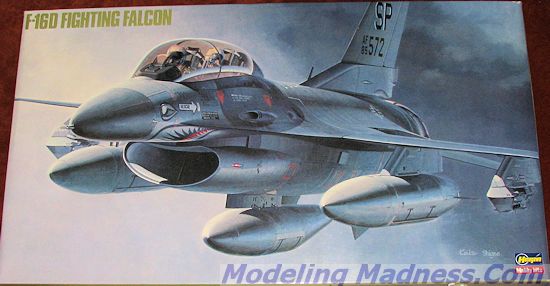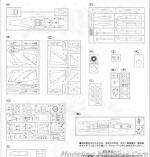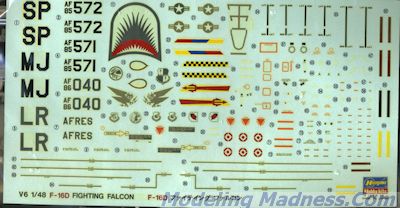
| KIT #: | 06106 |
| PRICE: | 1500 yen when new, currently $75.00 on e-paid. |
| DECALS: | Three options |
| REVIEWER: | Scott Van Aken |
| NOTES: | 1989 basic boxing |

| HISTORY |
The F-16C (single seat) and F-16D (two seat) variants entered production in 1984. The first C/D version was the Block 25 with improved cockpit avionics and radar which added all-weather capability with beyond-visual-range (BVR) AIM-7 and AIM-120 air-air missiles. Block 30/32, 40/42, and 50/52 were later C/D versions. The F-16C/D had a unit cost of US$18.8 million (1998). Operational cost per flight hour has been estimated at $7,000 to $22,470 or $24,000, depending on calculation method. Most Block 30/32/40/42 aircraft have been mothballed
| THE KIT |
 Hasegawa
brought out the first really well done 1/48 F-16s quite some time ago and
until relatively recently, they had no competition. When the F-16C/D came
around, they added a sprue or two to take care of the major airframe
differences while still leaving the basic F-16A/B kit as it was because so
many of the parts were the same in the two aircraft variants.
Hasegawa
brought out the first really well done 1/48 F-16s quite some time ago and
until relatively recently, they had no competition. When the F-16C/D came
around, they added a sprue or two to take care of the major airframe
differences while still leaving the basic F-16A/B kit as it was because so
many of the parts were the same in the two aircraft variants.
When doing their two seat Falcons, Hasegawa did produce an entire new upper fuselage section. Other kit makers in both scale generally had an insert for the upper forward portion of the fuselage to take into consideration the additional seat.
So let's have a look at what is offered in the kit First off you get two five piece ACES seats. These are fairly nice, but if you want real detail, get resin replacements. The kit does come with crew members so the lack of seat detail and harness can be covered by these figures. The figures have separate right arms and helmets. There are two separate tubs for the seats. These are identical with a nice instrument panel, rudder pedals and a control stick. The instrument panel and side consoles have raised detail. These fit into the floor of the lower fuselage half. There is also a throttle piece that fits into the side of the upper fuselage half.
Wings are an upper and lower section with the large holes for the pylons already drilled out. The upper wing half contains the flap, aileron and slat piece so any seam filling will be on the underside of the wing. THe intake is a five piece construct with separate nose gear well/lower ducting piece, two side pieces an intake front piece and the intake brace. This fits into the lower fuselage half.
The kit offers the option of open or closed speed brakes, but these planes are rarely seen on the ground with them open so most of us model them closed. There is a somewhat complex exhaust section that also includes the rear fuselage piece. The burner can on this one is six sections that needs to be glued onto the aft fuselage housing. landing gear is well done and properly complex with gear door actuating hinges. I'm not sure when the F-16C/D went to bulged gear doors, but this kit does not have those.
The large canopy can be posed open or closed and comes with an actuating cylinder and canopy brace. A single boarding ladder is also provided. For things under wings you have two large wing fuel tanks, a smaller centerline tank, as well as AMRAAM and Sidewinder missiles. A travel pod is supplied as well. The racks which would hold bombs are provided with TERs but no bombs.
Instructions are the usual for
Hasegawa with Gunze paint references. Markings are provided for three
aircraft. One is the shark mouth version from the 480 TFS /52 TFW which was
based in Europe. For the Pacific is the Misawa based 14 TFS/432 TFW while
the US crowd gets a 302TFS/944 TFG plane with the reserves. Out of these
three units, the 14th FS is the only one that has stayed operational since
the kit came out. The 480th was disbanded in the early 1990s only to later
reform as a training unit for Turkish F-16 pilots a few years back. The
302nd lost all its planes in the 1990 due to unit draw-downs and is now
based in Elmendorf with no planes, but as the reserve component of the F-22
squadron flying from there. For those of you who don't know what a 'reserve
component' is,
 this
means that they own no planes. Instead they are 'attached' to a regular USAF
unit and allowed to use their aircraft during reserve training. If it is
like what happened to the 110FS in St. Louis, which is now a reserve
component of the B-2 wing at Whiteman AFB, it means they don't get a ton of
flying done as the regular USAF unit is often loathe to let part timers fly
their expensive planes. Anyway, the decal sheet is nicely printed, but
is old school Hasegawa so is thick and despite being in a sealed back until
I opened it for this preview, is starting to yellow.
this
means that they own no planes. Instead they are 'attached' to a regular USAF
unit and allowed to use their aircraft during reserve training. If it is
like what happened to the 110FS in St. Louis, which is now a reserve
component of the B-2 wing at Whiteman AFB, it means they don't get a ton of
flying done as the regular USAF unit is often loathe to let part timers fly
their expensive planes. Anyway, the decal sheet is nicely printed, but
is old school Hasegawa so is thick and despite being in a sealed back until
I opened it for this preview, is starting to yellow.
| CONCLUSIONS |
In all, this is still a nice kit. Finding aftermarket decals for it shouldn't be much of an issue as there have been a TON of Falcon sheets done over the year. What I did not realize until researching it is that I have a rare and expensive kit. At least it is according to the e-paid listings!
| REFERENCES |
http://en.wikipedia.org/wiki/General_Dynamics_F-16_Fighting_Falcon
October 2014
Thanks to me
for the preview kit.
If you would like your product reviewed fairly and fairly quickly, please
contact the editor or see other details in the
Note to
Contributors.